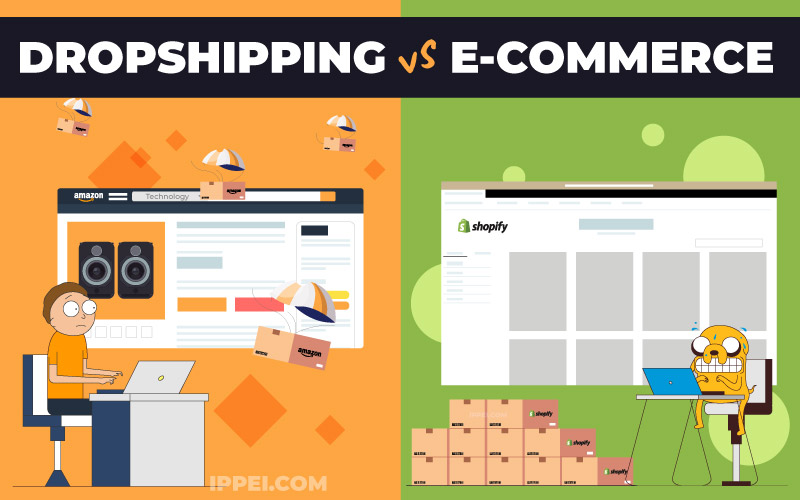In the expansive realm of online business, two distinct models have emerged as front-runners: dropshipping and traditional e-commerce. However, these two methods often confound individuals seeking clarity. This article endeavours to elucidate the disparities, advantages, shortcomings, and difference between dropshipping and E-commerce. It also provides with the insights necessary to make an astute decision for your online venture.
Setting the Stage
Before we delve into the specifics, it is imperative to establish context. Our primary objective is to assist you in determining the approach best suited to your online business. To achieve this, we will delineate the mechanics of both dropshipping and traditional e-commerce while elucidating the pros and cons of each method.
Understanding Dropshipping
Let us commence with dropshipping, a method that has surged in popularity in recent times. In fact, there are ample ways to create free dropshipping websites and run your business at your convenience.
Here is an overview of how it operates:
1. Finding a Partner: The journey commences with the identification of a reputable dropshipping supply partner who specializes in the products you intend to sell.
2. Product Listing: Subsequently, you list your partner’s inventory on your e-commerce website, transforming your website into the platform for showcasing these products.
3. Marketing: Your responsibility is to promote these products to potential customers, often involving strategies like Facebook ads or analogous advertising methodologies.
4. Order Processing: When a customer expresses interest in your products and places an order, you, in turn, place the same order with your dropshipping supply partner.
5. Fulfillment: Crucially, your partner manages warehousing, packaging, and shipping directly to the customer. Your involvement in the shipping process is minimal.
Dropshipping Pros:
Low Initial Investment: Embarking on this venture requires minimal upfront capital, as there is no need to purchase and store inventory.
Reduced Risk: The risk of unsold inventory is minimal since product procurement only occurs when a sale is made.
Access to a Wide Range of Products: You can offer a diverse selection of products without the logistical challenge of storage.
Potential for Automation: Many facets of dropshipping can be automated, affording you the capability to manage your business remotely.
Lower Startup Costs: Without the need to invest in inventory, your initial expenses remain relatively low.
Dropshipping Cons:
Narrow Profit Margins: Profit margins can be slender due to higher costs for single units and competition predominantly on price.
Intense Competition: The low entry barrier results in intense competition, potentially leading to price wars.
Long Shipping Times: Customers may face extended shipping times, often originating from suppliers in remote locations.
Quality Control: Your influence over product quality is limited, which may impact customer satisfaction.
Handling Returns: Managing returns can be intricate, and you may be left with unsellable inventory.
Traditional E-commerce: A Hands-On Approach
Now, let’s pivot our focus toward traditional e-commerce:
1. Inventory Management: In this model, you procure and maintain your inventory of products.
2. Product Listing: Subsequently, you list your inventory on your e-commerce website, granting you complete control over product descriptions and pricing.
3. Order Fulfillment: When a customer places an order, the responsibility falls squarely on you to package and ship the product directly to the customer.
Traditional E-commerce Pros:
Better Profit Margins: By purchasing products in bulk at advantageous rates, you can enjoy higher profit margins.
Control over Quality: You wield greater control over product quality and can implement rigorous quality control measures.
Flexible Shipping: Offering expedited shipping options enhances the customer experience.
Greater Control: Managing all facets of your business, from pricing to customer service, affords you a comprehensive level of control.
Traditional E-commerce Cons:
Higher Initial Investment: Acquiring inventory necessitates a more substantial upfront capital commitment, with potential ongoing storage costs.
Inventory Management: Holding stock carries the inherent risk of unsold inventory, which can tie up your capital.
Hands-On Operation: Traditional e-commerce mandates your daily involvement and hands-on management.
Making the Choice
Ultimately, the choice between dropshipping and traditional e-commerce hinges on your business objectives, available resources, and risk tolerance. Both methods offer unique advantages but cater to different needs. To arrive at an informed decision, assess your business plan, conduct thorough market research, and consider your financial capabilities.
In conclusion, my preference leans toward traditional e-commerce due to its control and profit potential. Nonetheless, dropshipping can serve as a valuable testing ground for product concepts. It is crucial to emphasize that there is no one-size-fits-all answer; your choice should align precisely with your distinct business objectives.
I trust that this article has effectively elucidated the disparities between dropshipping and traditional e-commerce, empowering you to chart a course for your online business expedition.








